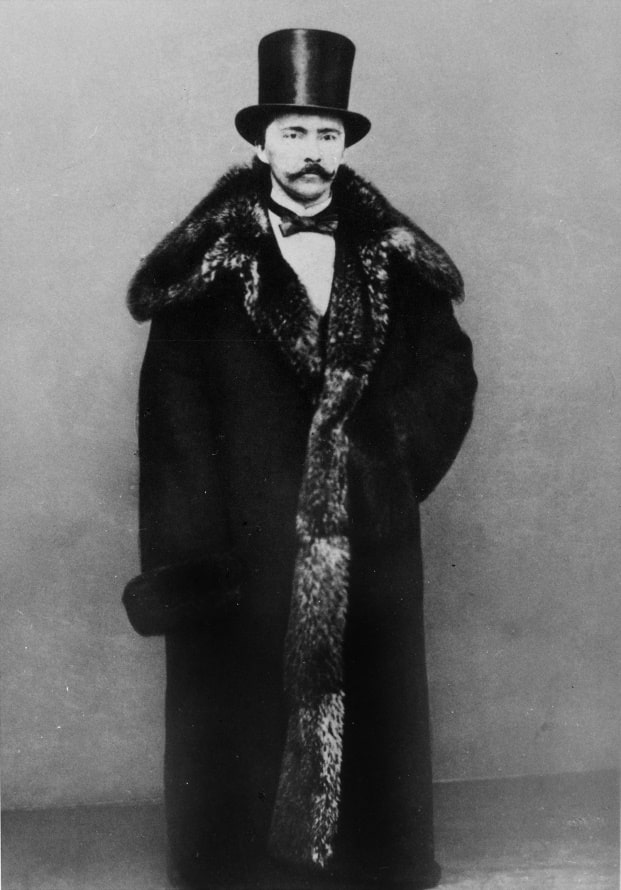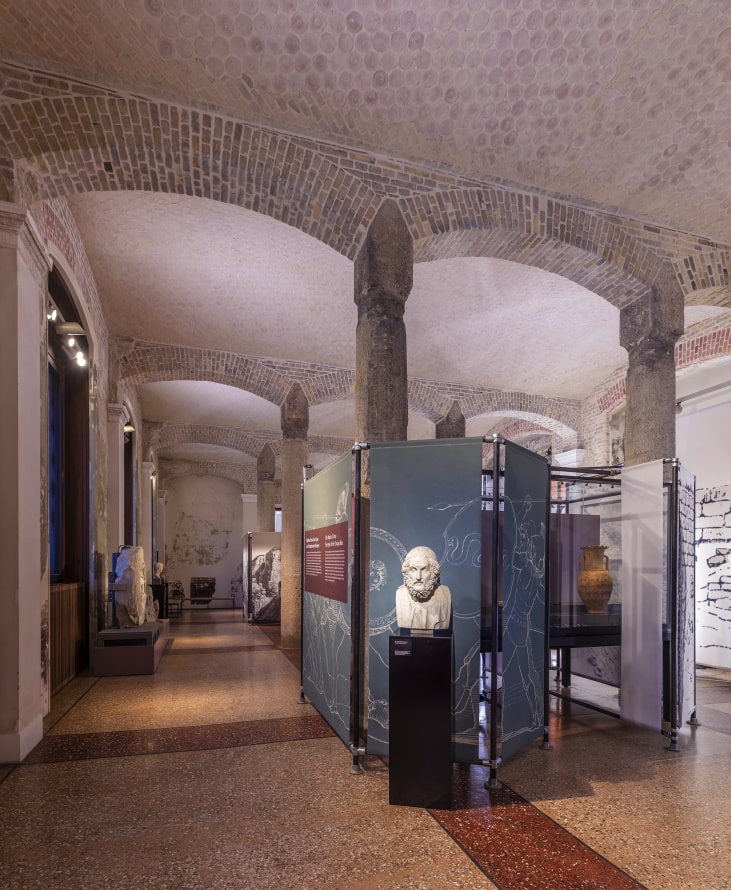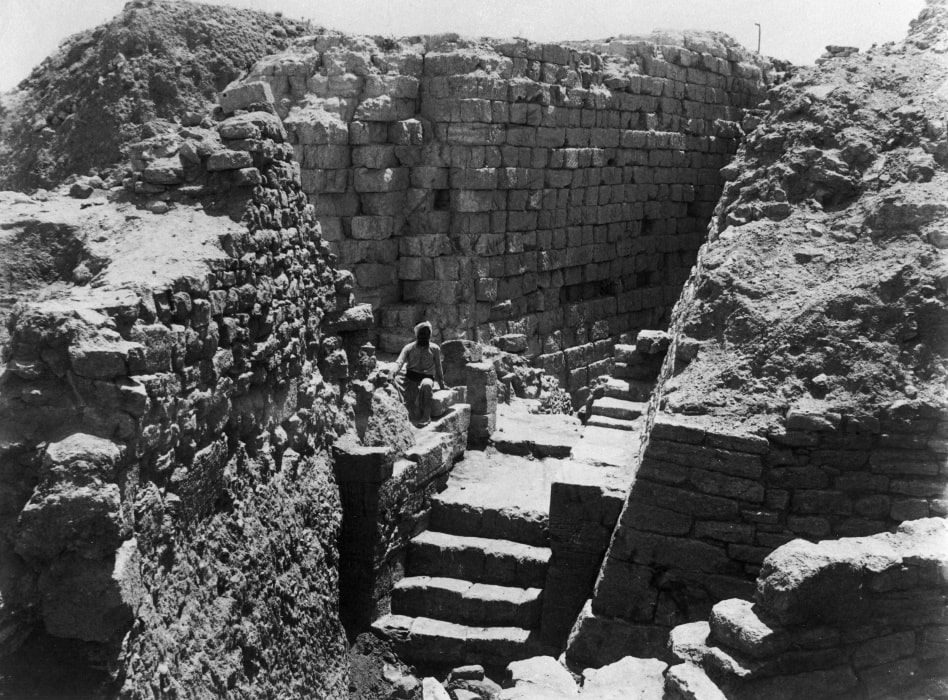Heinrich Schliemann (1822-1890) became world-famous as the discoverer of Troy. On the occasion of the 200th anniversary of his birth, the special exhibition of the Museum of Prehistory and Early History takes a differentiated look at his enigmatic personality. It is the story of a risk-taking up-and-comer who started out as a merchant’s assistant, went to Russia as a merchant, earned millions in the Californian gold rush and the Crimean War, and turned to his true passion in his early 40s: the study of antiquity. Celebrated as a hero and visionary by some, reviled as a fantasist and fraud by others, his archaeological methods were controversial then as now. Based on current research findings, the exhibition for the first time takes a look at Schliemann’s adventurous life up to his turn to archaeology, before focusing on his archaeological discoveries, which are still fascinating today.
Image above: Excavations in Troy, 1890s, © bpk
According to the self-created myth, Schliemann had already decided at the age of seven that he would once excavate Troy. However, if one follows the path up to his great turn in life in 1869, doubts at least arise. After an apprenticeship as a grocer, he boarded a ship in Hamburg at the age of 19 to emigrate to Venezuela. The journey ended in a storm off the Dutch coast and took the rescued man to Amsterdam. He found employment in a trading house and here began his rise to become a millionaire St Petersburg merchant. During the Amsterdam years, he began to learn foreign languages almost obsessively, which would prove to be the key to his success. By the end of his life, Schliemann had mastered at least 17 languages.
With astonishing intuition and a high willingness to take risks, he ran his extremely lucrative business until the mid-1850s. The economic crisis of 1857 and the increasingly disrupted marriage he had entered into with the Russian Ekaterina Petrovna Lyshina in 1852 led to a life crisis and search for meaning that lasted several years. Schliemann liquidated his company and in 1864 embarked on a two-year journey around the world, whose travelogue “La Chine et le Japon au temps présent” he published in 1867. Paris became his new centre of life, where he took up philological and literary studies at the Sorbonne.

© Staatliche Museen zu Berlin, Museum für Vor- und Frühgeschichte
When Schliemann went in search of the places described by Homer in Greece and Asia Minor in 1868, the decision was made. On Ithaca he searched for the palace of Odysseus, on the Peloponnese he visited the ruins of Corinth, Mycenae and Tiryns, to finally take up the search for Troy not far from the Dardanelles in Asia Minor. In 1869, the year of destiny, his second book “Ithaka, der Peloponnes und Troja” (Ithaca, the Peloponnese and Troy) was published, in which he presented his theses on the localisation of the sites described by Homer. This work helped him to gain a doctorate at the University of Rostock. In the same year, Schliemann married Sophia Engastroménos, a Greek thirty years his junior, who was to share his enthusiasm for Homer from then on.
After the illegal trial excavation of 1870, Schliemann undertook a total of seven excavation campaigns on the settlement mound of Hisarlık (Turkey) until his death. When he discovered a large gold treasure there in the summer of 1873, he saw himself at the goal of his search for Homer’s Troy. His “Treasure of Priam” made him a world-famous archaeologist in one fell swoop. The autodidact’s struggle for recognition in the academic world began. His fame, however, soon increased considerably when in 1876, during his excavations at the castle of Mycenae, he discovered five shaft tombs in which a total of fifteen men, women and children were buried with exceptional grave goods. Excavations in Orchomenos and Tiryns followed, but he always returned to Troy. The fact that the connection of his finds with Homer’s heroes was not accurate, both in Troy and at the Greek sites, does not diminish his merit in having discovered the earliest advanced civilisation in Europe, the Bronze Age Mycenaean culture.
In 1880, Schliemann had a neo-Renaissance palace built for himself in Athens, with a magnificent interior that showcased his wealth, but above all his archaeological work. While the Greek finds remained in the country and are presented today in the National Archaeological Museum in Athens, he donated his collection of Trojan antiquities in 1881 “to the German people for eternal safekeeping in Berlin”. Today, the famous collection is one of the outstanding holdings of the Museum of Prehistory and Early History. The Trojan gold treasures, however, have been taken out of context and are still being held back in Russia as spoils of war since 1945, in violation of international law.

The first part of the exhibition in the James Simon Gallery is dedicated for the first time comprehensively to the path of the Mecklenburg village boy to businessman, cosmopolitan and travel writer up to the fateful year of 1869. The stations of his life in Amsterdam and St. Petersburg are presented, a Russian sleigh and a heavy, fur-trimmed winter coat transport visitors to the winter residence of the tsars, while only a short time later the foreign Chinese and Japanese world that Schliemann experienced on his world journey is created before the eyes of the visitors. With the help of outstanding objects, including the historical model of a Chinese burial ceremony, which is on display for the first time, the detailed descriptions that also distinguished Schliemann as a travel writer become apparent.
The second part in the Neues Museum presents Schliemann’s archaeological discoveries. The visitors virtually walk through the famous Schliemann ditch, which the excavator drove through the settlement mound, and come across many previously unseen objects from the rich holdings of the Troy collection. Then the path leads along the Lion’s Gate into the middle of the area of the tombs from Mycenae. The spectacular gold finds from Mycenae form the impressive highlight of the archaeological part. Finally, the host invites you to his “Iliou Melathon”, his “Palace of Troy”, where the Schliemann couple hosted lavish receptions and balls for Athenian society. Even a glimpse into his study, furnished with the original furniture, is possible.
Actress Katharina Thalbach revives Schliemann for the exhibition project with original quotes and wonderful irony. In six film scenes, visitors to the exhibition encounter Heinrich Schliemann alias Katharina Thalbach – with his account of the allegedly legendary Christmas of 1829, as a shipwrecked man, shrewd millionaire, world traveller hungry for education, discoverer of the “Treasure of Priam” and landlord of the “Iliou Melathron”.

Neues Museum 2022, © Staatliche Museen zu Berlin / David von Becker
“Schliemann’s Worlds” is curated by Marion Bertram, Bernhard Heeb, Susanne Kuprella, Sebastian Olschok, Benjamin Wehry and Anton Gass under the project management of Matthias Wemhoff, Director of the Museum of Pre- and Early History.
The exhibition is made possible by the support of the Ministry of Culture and Sports of the Hellenic Republic, the National Archaeological Museum of Athens, the American School of Classical Studies at Athens, which preserves Schliemann’s extensive written legacy, and the Municipal Art Gallery of Larissa, G.I. Katsigras Museum. Furthermore, numerous loans from all over Germany are represented. Within the National Museums in Berlin, there is close cooperation with the Egyptian Museum and Papyrus Collection, the Collection of Classical Antiquities, the Ethnological Museum, the Gipsformerei, the Art Library, the Museum of Decorative Arts, the Museum of Prints and Drawings, the Numismatic Collection and the Museum of Asian Art.
The exhibition is supported by the Kuratorium Preußischer Kulturbesitz, the Stiftung Deutsche Klassenlotterie and the Hauptstadtkulturonds. Media partners are Exberliner, rbb24 Inforadio, HIMBEER, Tagesspiegel and tip Berlin.
An accompanying publication will be published by E. A. Seemann Verlag Leipzig: 320 pages with more than 300 colour illustrations, hardcover, ISBN 97-3- 86502-480-0.
WHEN?
Exhibition dates: Friday, 13 May – Sunday, 6 November 2022
Opening hours: Tue – Sun 10 – 18 h
WHERE?
Museum Island Berlin, James-Simon-Galerie + Neues Museum
Bodestraße
10178 Berlin-Mitte






